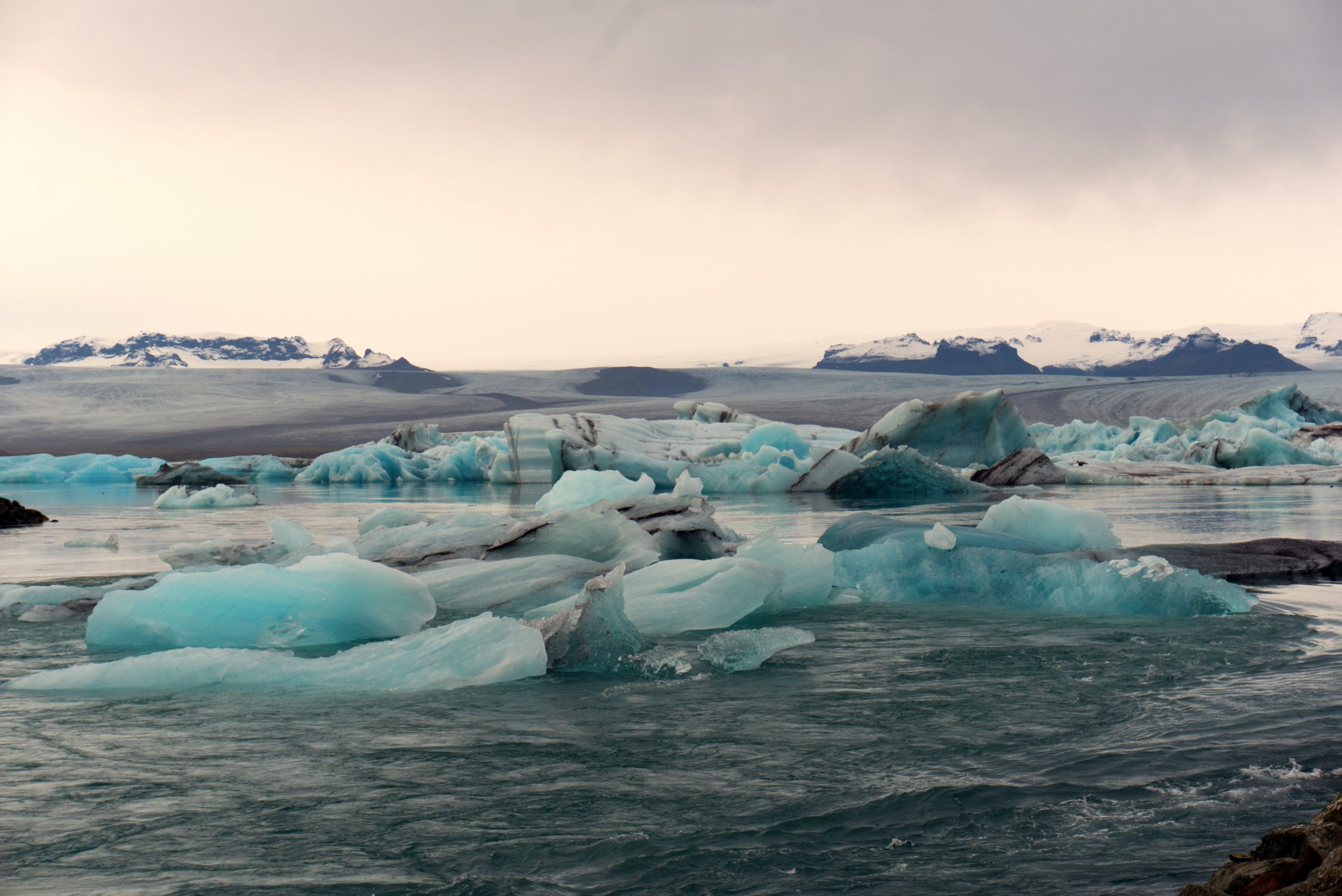In part one of this series, we discussed how tourism and climate change are inextricably linked. Nature-based tourism is becoming increasingly vulnerable to changing weather patterns, while the nature of tourism itself contributes 8% of global emissions. The landmark Glasgow Declaration on Climate Action in Tourism – launched at COP26 – urged destinations and the tourism industry to reduce carbon emissions by 50% before 2030, and reach Net Zero as soon as possible by 2050. Solimar Internationa’s recent white paper publication echoed this commitment, designing Five Principles for tourism businesses to invest in Nature-based Solutions to respond to the causes and consequences of climate change (see photo). In addition to a mitigation pathway of measuring and reducing emissions, it is imperative for governments and businesses to simultaneously invest in climate change adaptation – using tourism as a means to build, finance and sustain climate resilient destinations.
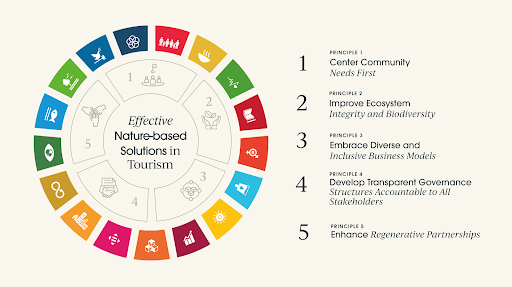
Five Principles for Effective Nature-based Solutions in Tourism from Solimar International’s report Climate Action through Regeneration: Unlocking the Power of Communities and Nature through Tourism
The World Economic Forum (2020) estimated that over half of global GDP, US $44 trillion, is potentially threatened by loss of nature and biodiversity, while the transition to a nature-positive economy could create 395 million jobs by 2030, or around one fifth of the total projected increase in global labor force (World Economic Forum, 2020). Global investments in NbS already surpassed US $133 billion in 2020—only 14% of which came from private finance (UNEP, 2021a; UNEP and IUCN, 2021). The UN State of Finance for Nature report 2021 argues this investment must triple by 2030 if we are to meet global climate and biodiversity goals.
The second in this article series showcases how we can increase investment in nature in destinations around the world–including those that we support through our international development projects–to respond to the consequences of climate change by investing in actions that will protect and restore nature and communities.
The Sundarbans Reserve Forest – Bangladesh
The Sundarbans Reserved Forest in Bangladesh is the largest mangrove forest on Earth, home to the Bengali tiger and hundreds of bird, fish, mammal, and reptile species. Spanning three wildlife sanctuaries across 317,950 hectares, including Ramsar and World Heritage Sites, the Sundarbans provides sustainable livelihoods for millions of people and act as a shelter belt to protect communities from storms, cyclones, tidal surges, and seawater intrusion.
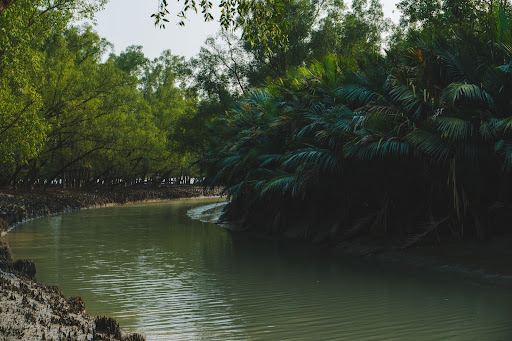
The Sundarbans Reserve Forest in Bangladesh. Photo by Chloe King
A total of 7.79 million people live in the Sundarbans Impact Zone, with about 28 percent of people from this zone directly dependent on the Sundarbans for their livelihoods, including as woodcutters, fishermen, and gatherers of honey, leaves, and grass. However, according to a recent study, Bangladesh lost 73 percent of mangrove forest cover since the 1960s, with only 11 percent of the country remaining forested (Bangladesh Forest Inventory). Nearly 2.5 million people depend upon the SRF for their livelihoods (Gopal and Chauhan, 2018), and the mangrove forest naturally shields millions from increasingly erratic weather events, such as Cyclone Amphan that hit the coast in 2020, the most powerful to strike Bangladesh in 20 years (AlJazeera, 2020). Unsustainable development, such as the Ramsar Coal Fired Power Plant, under construction only 4km away from the buffer zone of the SRF may provide jobs, but ultimately risk undermining the natural climate protection the SRF offers (Chowdhury, 2017).
USAID/Bangladesh, in partnership with the Bangladesh Ecotourism and Conservation Alliance (BECA) implemented by Solimar International and the Government of Bangladesh, is currently focusing on interventions in and this iconic tourism destination and arguably most important protected area. By ensuring that tourism develops sustainably and is better distributed to local communities, this project hopes to reduce pressure on natural resource extraction, while also deterring environmentally destructive industries from developing around the periphery of the reserve. The communities living around the periphery of the last great mangrove forest cannot afford to lose the living lungs of the Earth. Without nature and wildlife, humanity can neither address the climate crisis as a whole, nor save those who are most vulnerable to its consequences.
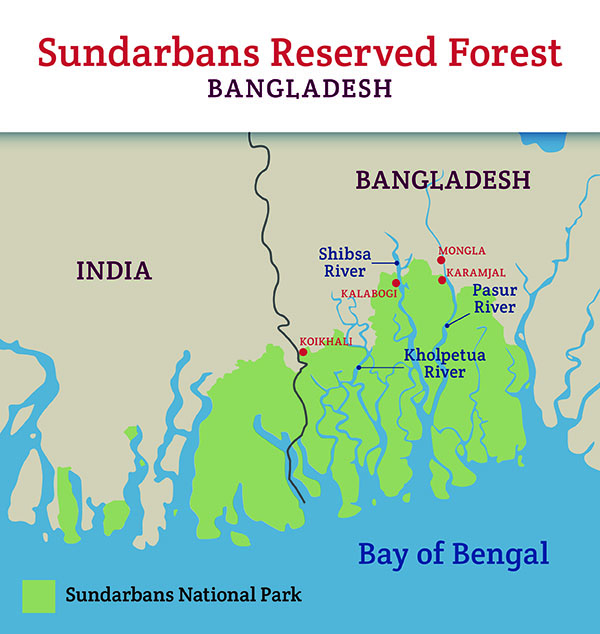
Climate Change Adaptation in the Maldives and Sri Lanka
Climate risks in the Maldives and Sri Lanka are growing in frequency and intensity. Sea level rise, coastal storm surges, and flooding pose a significant threat to the Maldives, where more than 80% of the land area is less than one meter above sea level. Flooding and drought in Sri Lanka are among many of the consequences of climate change that negatively impact the most important elements of Sri Lanka’s economy. For these reasons, both countries have policy frameworks in place that identify climate change risks and prioritize adaptation strategies.
The USAID Climate Adaptation Project (CAP) is a five-year project in the Maldives and Sri Lanka where its purpose is to enhance the adaptive capacities of the public and private sectors and local communities to respond to the impact of climate change. The first year of the activity (2022) is focused on the Maldives, and Solimar International is leading the private sector engagement for the project. CAP will help identify and scale up solutions to climate-related challenges, strengthen governance to address climate-related risks, and improve access to high-quality information for decision-making to reduce vulnerability to climate change. Solimar will support this work by identifying innovative solutions to adaptively manage climate-related risk through market-driven private sector and community engagement.
Tourism operators in the Maldives have the unique ability to take advantage of increased interest in and funding for Nature-based Solutions for climate mitigation, while simultaneously utilizing these same solutions to respond to societal challenges and help their respective destinations adapt to the realities of climate change. Tourism can play an important role in helping communities adapt to this new reality and build resilience to future risks. For example, many of the resorts and tourism businesses in the Maldives are already investing in coral reef restoration through organizations such as Reefscapers. However, interviews with businesses revealed that this restoration work is not being done in a consistent or effective manner, with lack of national policy guidelines for tourism operators.
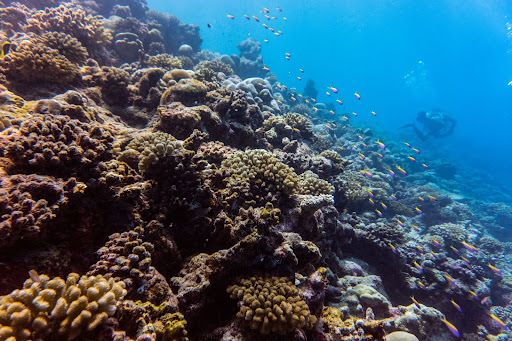
Coral reef ecosystems in the Maldives are threatened by climate change and coastal tourism development. A more sustainable industry can help to mitigate both of these threats. Photo by Chloe King
An example of nature based solutions include mangrove tourism projects. On the Maldives’ Huvadhoo Atoll, mangroves were covered with sand to reduce mosquito populations; however, flooding also increased as a result. Local communities pushed for restoration and the construction of eco-huts which linked tourism and mangrove restoration. Solimar is exploring opportunities for destination management at other mangrove sites in the Maldives, linking mangrove ecotourism to support conservation. These models of nature based solutions can be further explored to link tourism and climate change adaptation.
Another opportunity for tourism to be involved in climate adaptation includes creating structures that protect and nourish sand and shorelines in ways that are nature-based and nature-positive. For example, living sea walls can be created as a blend of hard engineering seawall solutions that foster growth in coral and other marine life. This could offer an opportunity to resorts in the Maldives that are looking to invest in sea walls to create more environmentally-friendly and adaptive solutions.
Are you a tourism business or destination with innovative ideas for climate adaptation? Are you financing nature restoration or protection in new or exciting ways? Take our survey here for a chance to be a featured business in an upcoming white paper publication: https://tinyurl.com/enterprise-nbs-survey
By Shivya Nath, Alexandria Kleinschmidt, Annie Combs, and Chloe King
